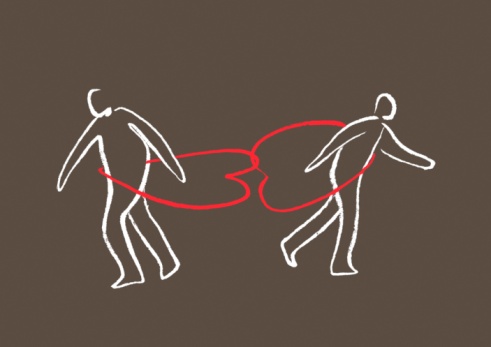
I sat in on a seminar recently with a room full of moms. Moms of babies, moms of toddlers, moms with children just starting elementary school. The topic was about learning to fall in love with your husband again, and the speaker was a woman in her 70’s. The dialog was mainly, “Do this to keep your husband happy, do that to keep your husband happy…” I think many were wondering why they got up early on a Tuesday morning to listen to old-fashion marriage advice. However, in between the eye rolls of many overtired moms, I caught the true message of the speech – don’t forget about your marriage, the kids are wonderful, but if you make them your whole world, they leave the nest, and the marriage is over.
I had not really thought about empty nest syndrome in this sense. I had mainly thought about the kids going off to college and the parents are alone in a big empty house, they are a little lonely, maybe start a new hobby, and life goes on. Only life doesn’t go on, at least not in that sense. Divorce after decades, the graying divorce, divorce after 50, whatever you may call it, is becoming more and more common. Decades of putting the kids first, likely putting the career second, and well, the marriage must have fallen down on the priority list.
When children are babies and toddlers they require about every last bit of energy you have; once they start school it’s homework, sports, and juggling schedules. Making it all too easy for the better part of 20+ years for your marriage to be entirely kid-centric. The graying divorce gives new meaning to staying together for the kids. The couple in many of these marriages might not have even seen it coming. Years of enjoying the children together – family vacations, neighborhood outings, cheering the kids on together from the sidelines, only to wake up one day and realize they no longer have anything in common, the kids were all they had in common.
A half-century ago, only 2.8 percent of Americans older than 50 were divorced. In 2011, according to the Census Bureau’s American Community Survey, 15.4 percent were divorced and another 2.1 percent were separated. Was it that divorce was more taboo 50 years ago, or maybe because people are living longer these days? A healthy 60 year old might look at it in terms of having 20+ years left; 20+ years that they are choosing to be happy, and ditching the unhappy marriage. Baby boomers are setting record high divorce numbers.
If you found yourself amongst this new era of divorce, the good news is you are in good company! There are support groups nationwide that are catering specifically to the increase in baby boomers and their graying divorces. Seek out divorcees going through a similar situation and create a support system. Most importantly, keep on living – enjoying yourself, pursue your interests, take on a new hobby, travel, and make the most of your new-found free time!
 While it is possible to file for divorce in Minnesota on your own, without legal representation, it can be difficult to manage, not only legally but also emotionally. Here are some reasons to have an attorney and NOT try and represent yourself:
While it is possible to file for divorce in Minnesota on your own, without legal representation, it can be difficult to manage, not only legally but also emotionally. Here are some reasons to have an attorney and NOT try and represent yourself:



 Collaborative Divorce was started in Minnesota 25 years ago and has spread to more than 20 countries because it meets two basic needs felt by divorcing couples around the world. What does it mean to say that a divorce is Collaborative?
First, it is important to understand that difference between the formal Collaborative divorce process (with a capital C) and the use of the word collaborative. To be collaborative simply means to work together and, in that sense, any divorce in which people work together could be described as collaborative, (small c). However, the Collaborative divorce process is something distinctly different.
Most people want to keep their divorce amicable, and Collaborative Divorce gives them the tools to work out of court to make that happen. At the same, people facing divorce want to know that they are protected; that they have someone looking out for their interests. Collaborative Divorce provides each party with an attorney who will work with them to help them achieve their most meaningful goals.
In a Collaborative Divorce, the attorneys must withdraw if the matter goes to court in an adversarial proceedings. That is the one rule. A rule that is simple and yet, changes the entire tenor of the divorce negotiation. It is a great example of addition by subtracting. By subtracting one element, (the ability of the lawyers to fight), a door is opened to add many more valuable tools (true interest based-bargaining, teaming with financial experts and mental health professionals, deeper solutions, etc.). That one change redefines the negotiation and creates a ripple effect that, if handled in a skillful manner, creates many more options.
People sometimes hire aggressive lawyers, reluctantly; believing that their spouse will be aggressive and that they, therefore, need to “fight fire with fire”. The problem, of course, is that fighting fire with fire means there is a great risk that someone (maybe everyone) will get burned.
Collaborative Divorce, with the agreement not to fight, is intended to put out the fire, so that you, and your spouse, can build their future on solid ground. That is not easy to achieve. It requires skill and commitment. An attorney who cannot use argument and fighting must have other skills. Equally important, clients who intend to achieve their highest goals without fighting must be prepared to work on developing other skills as well.
To learn more about the Collaborative Process and to find experts with skill and experience in this area, go to
Collaborative Divorce was started in Minnesota 25 years ago and has spread to more than 20 countries because it meets two basic needs felt by divorcing couples around the world. What does it mean to say that a divorce is Collaborative?
First, it is important to understand that difference between the formal Collaborative divorce process (with a capital C) and the use of the word collaborative. To be collaborative simply means to work together and, in that sense, any divorce in which people work together could be described as collaborative, (small c). However, the Collaborative divorce process is something distinctly different.
Most people want to keep their divorce amicable, and Collaborative Divorce gives them the tools to work out of court to make that happen. At the same, people facing divorce want to know that they are protected; that they have someone looking out for their interests. Collaborative Divorce provides each party with an attorney who will work with them to help them achieve their most meaningful goals.
In a Collaborative Divorce, the attorneys must withdraw if the matter goes to court in an adversarial proceedings. That is the one rule. A rule that is simple and yet, changes the entire tenor of the divorce negotiation. It is a great example of addition by subtracting. By subtracting one element, (the ability of the lawyers to fight), a door is opened to add many more valuable tools (true interest based-bargaining, teaming with financial experts and mental health professionals, deeper solutions, etc.). That one change redefines the negotiation and creates a ripple effect that, if handled in a skillful manner, creates many more options.
People sometimes hire aggressive lawyers, reluctantly; believing that their spouse will be aggressive and that they, therefore, need to “fight fire with fire”. The problem, of course, is that fighting fire with fire means there is a great risk that someone (maybe everyone) will get burned.
Collaborative Divorce, with the agreement not to fight, is intended to put out the fire, so that you, and your spouse, can build their future on solid ground. That is not easy to achieve. It requires skill and commitment. An attorney who cannot use argument and fighting must have other skills. Equally important, clients who intend to achieve their highest goals without fighting must be prepared to work on developing other skills as well.
To learn more about the Collaborative Process and to find experts with skill and experience in this area, go to 





 I sat in on a seminar recently with a room full of moms. Moms of babies, moms of toddlers, moms with children just starting elementary school. The topic was about learning to fall in love with your husband again, and the speaker was a woman in her 70’s. The dialog was mainly, “Do this to keep your husband happy, do that to keep your husband happy…” I think many were wondering why they got up early on a Tuesday morning to listen to old-fashion marriage advice. However, in between the eye rolls of many overtired moms, I caught the true message of the speech – don’t forget about your marriage, the kids are wonderful, but if you make them your whole world, they leave the nest, and the marriage is over.
I had not really thought about empty nest syndrome in this sense. I had mainly thought about the kids going off to college and the parents are alone in a big empty house, they are a little lonely, maybe start a new hobby, and life goes on. Only life doesn’t go on, at least not in that sense. Divorce after decades, the graying divorce, divorce after 50, whatever you may call it, is becoming more and more common. Decades of putting the kids first, likely putting the career second, and well, the marriage must have fallen down on the priority list.
When children are babies and toddlers they require about every last bit of energy you have; once they start school it’s homework, sports, and juggling schedules. Making it all too easy for the better part of 20+ years for your marriage to be entirely kid-centric. The graying divorce gives new meaning to staying together for the kids. The couple in many of these marriages might not have even seen it coming. Years of enjoying the children together – family vacations, neighborhood outings, cheering the kids on together from the sidelines, only to wake up one day and realize they no longer have anything in common, the kids were all they had in common.
A half-century ago, only 2.8 percent of Americans older than 50 were divorced. In 2011, according to the Census Bureau’s American Community Survey, 15.4 percent were divorced and another 2.1 percent were separated. Was it that divorce was more taboo 50 years ago, or maybe because people are living longer these days? A healthy 60 year old might look at it in terms of having 20+ years left; 20+ years that they are choosing to be happy, and ditching the unhappy marriage. Baby boomers are setting record high divorce numbers.
If you found yourself amongst this new era of divorce, the good news is you are in good company! There are support groups nationwide that are catering specifically to the increase in baby boomers and their graying divorces. Seek out divorcees going through a similar situation and create a support system. Most importantly, keep on living – enjoying yourself, pursue your interests, take on a new hobby, travel, and make the most of your new-found free time!
I sat in on a seminar recently with a room full of moms. Moms of babies, moms of toddlers, moms with children just starting elementary school. The topic was about learning to fall in love with your husband again, and the speaker was a woman in her 70’s. The dialog was mainly, “Do this to keep your husband happy, do that to keep your husband happy…” I think many were wondering why they got up early on a Tuesday morning to listen to old-fashion marriage advice. However, in between the eye rolls of many overtired moms, I caught the true message of the speech – don’t forget about your marriage, the kids are wonderful, but if you make them your whole world, they leave the nest, and the marriage is over.
I had not really thought about empty nest syndrome in this sense. I had mainly thought about the kids going off to college and the parents are alone in a big empty house, they are a little lonely, maybe start a new hobby, and life goes on. Only life doesn’t go on, at least not in that sense. Divorce after decades, the graying divorce, divorce after 50, whatever you may call it, is becoming more and more common. Decades of putting the kids first, likely putting the career second, and well, the marriage must have fallen down on the priority list.
When children are babies and toddlers they require about every last bit of energy you have; once they start school it’s homework, sports, and juggling schedules. Making it all too easy for the better part of 20+ years for your marriage to be entirely kid-centric. The graying divorce gives new meaning to staying together for the kids. The couple in many of these marriages might not have even seen it coming. Years of enjoying the children together – family vacations, neighborhood outings, cheering the kids on together from the sidelines, only to wake up one day and realize they no longer have anything in common, the kids were all they had in common.
A half-century ago, only 2.8 percent of Americans older than 50 were divorced. In 2011, according to the Census Bureau’s American Community Survey, 15.4 percent were divorced and another 2.1 percent were separated. Was it that divorce was more taboo 50 years ago, or maybe because people are living longer these days? A healthy 60 year old might look at it in terms of having 20+ years left; 20+ years that they are choosing to be happy, and ditching the unhappy marriage. Baby boomers are setting record high divorce numbers.
If you found yourself amongst this new era of divorce, the good news is you are in good company! There are support groups nationwide that are catering specifically to the increase in baby boomers and their graying divorces. Seek out divorcees going through a similar situation and create a support system. Most importantly, keep on living – enjoying yourself, pursue your interests, take on a new hobby, travel, and make the most of your new-found free time!